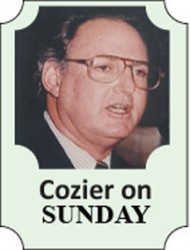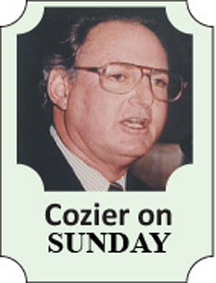Did those couple of specially arranged Tendulkar Tests in India really happen? Is it some myth that millions of Indians openly mourned the departure of their cricketing god?
Have the two defeats by an innings, both in less than three days, actually gone into the record books as the West Indies’ first in successive Tests since 2000 in Australia?
Did India’s batsmen strike 113 fours and eight sixes, a rate of a boundary every other over, in the 237.4 overs they supposedly batted, and was it a fact that two of the three West Indies’ fast bowlers failed to register a single maiden between them in 51 overs, the other just three in his 18?
Were the two terminal fete match swipes and his cut back to 21 barren overs by the captain, no less, some terrible illusion? And the same for much else besides, such as the umpires’ damning report on the action of the main bowler that, for the second time, places his very future in doubt.
In the Nation’s sports section last Wednesday, my fellow columnist Ezra Stuart felt the selectors were probably fast asleep throughout the entire debacle and, on awakening, dismissed it all as just a bad dream.
It is a theory not as facetious as it appears; play, after all, took place through the middle of our nights.
Certainly, it is as plausible an explanation as any for their blanket endorsement of the same 15 players in India for the forthcoming three Tests in New Zealand.

Former captains, Clive Lloyd and Brian Lara, and the widely respected Michael Holding and Andy Roberts, both outstanding fast bowlers in Lloyd’s great team in the Eighties, are among those speaking strongly about the need for change.
I’ve received more phone calls on the issue than ever from those with a deep feeling for West Indies cricket who cannot comprehend how such mediocrity could be rewarded with the stamp of approval.
The fury was accentuated by an utter sense of hopeless, that nothing can be done to reverse the foolishness; the unquestioning devotion of an already dwindling core of diehards is being severely tested. Many admit to no longer being able to watch the West Indies.
Yet, whatever they decide, or not do as the case may be, selection panels are always untouchable. So, now it appears, are the captain, the coach and the players.
The only addition for New Zealand is to the coaching staff; Stuart Williams, the Nevisian who opened in 31 Tests between 1994 and 2002, joins the Jamaican Andre Coley as the beleaguered Ottis Gibson’s second assistant, increasing the management’s numbers to nine.
Apart from ignoring the evidence from India, chairman Clyde Butts and his colleagues Courtney Browne and Robert Haynes have made no concessions to the completely different conditions they will encounter in New Zealand.
Returns from England’s back-to-back series in the same countries over the past year are instructive.
In India, spinners Graeme Swann and Monty Panesar shared 37 wickets in the four Tests; Jimmy Anderson’s 12 were the most by the couple of fast bowlers used.
In the drawn series in New Zealand two months later, Anderson and the other fast bowlers, Stuart Broad and Stephen Finn, collected 31 between them; Panesar, the only spinner chosen, had five from 130.2 overs at an average of 70.
West Indies’ spinners, such as they were, have had little impact in New Zealand in recent series (Chris Gayle has been the most successful on the last two tours). Fidel Edwards, Jerome Taylor and Darren Powell were the spearheads in 2005-06 and 2008-09.
This time, there are just three fast bowlers, the same ones who managed four wickets between them in India (Tino Best, Sheldon Cottrell and Shannon Gabriel). With Sammy now a reluctant medium-pacer, there is no genuine backup.
Where one will do, two specialist spinners were endorsed from India, Shane Shillingford and Veerasammy Permaul, along with the part-timers, Narsingh Deonarine and Marlon Samuels.
It is the wrong balance for pitches encouraging seam and swing rather than turn and bounce. A fourth fast bowler was surely required for Permaul who was dropped for the second Test in India.
As it is, both Shillingford, the only genuine wicket-taker over the past four Tests, and Samuels are before the International Cricket Council (ICC) for the second time because of their suspect actions; they are to be subjected to independent analysis within 21 days, with reports to be submitted to the ICC within a further 14.
That process is unlikely to be completed before the first Test in New Zealand starts on December 3; if Shillingford is included, he is open to the on-field umpires calling him for throwing until results of the assessments are known. It is a risk not worth taking.
When he endured the same process after the first Test in Sri Lanka in late 2010, the unsurprising effect on his bowling was clearly evident in the second match (15-0-73-0).
Once cleared, he made a strong return in 2012 with ten wickets against Australia in his native Roseau; before his latest problem, he had claimed five or more wickets in an innings five times in his previous four Tests.
The temptation to pick him is countered by the umpires’ particular reference to doubt over his ‘doosra’, a delivery as essential to his effectiveness as a bouncer is to a pacer. It is best to wait for the results and draft in the highly rated Sunil Narine instead.
For the different reason of a torn hamstring, there is doubt over Chris Gayle’s availability . The medical report following his hamstring tear in last Thursday’s ODI in India is that he will be sidelined for between two to four weeks. The former eliminates him from the first Test; at the age of 34, he is more likely to wait somewhat longer, missing all three Tests.
Gayle’s experience (whenever his next Test, it will be his 100th) and terrorizing power would make his a significant loss, especially in a land where he averages 67.5 in his previous five Tests.
As it was while he and the board were at loggerheads, a replacement would have to be found.
Selectors appear cagey over Kraigg Brathwaite’s moderate record in his nine previous Tests in Gayle’s absence (average 21.35). Two years on, his returns in 13 first-class matches in 2013 (1,025 runs, average 60.29, in the regional tournament and for the West Indies ‘A’ team against India and Sri Lanka) can hardly be overlooked.
He and Gayle are poles apart, in age (Brathwaite is 21 on December 1), physique (Brathwaite is a lightweight to heavyweight Gayle) and method (Brathwaite is a snail to Gayle’s hare). The West Indies could do with a couple of youthful snails, rather Twenty20 hares, at present.
New Zealand won’t be as tough as India (although the West Indies haven’t won a Test there on three tours since 1995) but, certainly at home and against a team whose self-belief has been clearly shot, it will be strong enough.
The outcome should determine the future of captain, coach, certain players and, above all, selectors.





